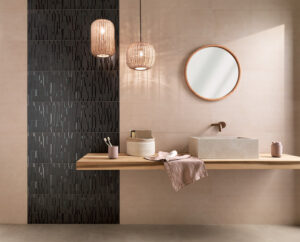designer bathroom tiles
While ceramic tile is a timeless bathroom flooring material, it’s not the only choice. Other materials like glass, stone and even interior wall paneling are becoming increasingly popular, especially for modern bathroom renovations. These new materials offer sleek, stylish looks while resisting moisture damage and providing slip resistance.
Using natural materials in your bathroom can add an instant sense of luxury. Marble is a particularly popular option for creating an opulent look, with unique veining and color variations that can’t be duplicated. It’s also a durable material that can stand up to a lot of wear and tear. However, marble is porous and can absorb water and soap residue, so it requires regular sealing to prevent staining and deterioration.

Another option for a luxurious but budget-friendly floor is porcelain tile. This type of designer tiles bathroom is a hard, dense material that comes in both glazed and unglazed finishes. Glazed tiles have a smooth, glossy sheen and are easy to wipe down and clean, while unglazed tile has a more matte finish that’s more textural. Some glazed porcelain tiles are even made with high-resolution digital images fused to their surface.
What are some innovative materials used in designer bathroom tiles?
Wooden walls create a cozy feel in bathrooms while offering a more natural aesthetic than tile or acrylic panels. While it is not a good idea to use wood in damp areas, such as behind the toilet or in shower cubicles, it can work well in other parts of the room — for example, over a freestanding bathtub (as shown in this bathroom by @theeclecticbeetle). This material is naturally waterproof and resists mildew and distortion from condensation. However, it can be difficult to keep clean and dry, and may warp or rot due to constant exposure to moisture.
A more durable and long-lasting option is concrete tile. This type of textured and colorful tile is usually made from recycled glass or other materials, and is fired at higher temperatures than traditional ceramics. It’s often used to create mosaic backsplashes and is a good choice for floors because of its high slip-resistance. It’s best to avoid concrete tiles with a glossy sheen, as this type of finish is more slippery than other finishes.
Glass tiles are a good option for bathroom flooring because they reflect light and add a pop of color to the space. They are available in a wide range of colors and can be printed with high-resolution digital images. They are also more water resistant than most other types of tile, making them a good choice for wet areas, but they can be brittle and scratch easily, so you’ll need to exercise caution when handling them.
Decorative tiles are available in a variety of materials and can be embossed or decorated with images, patterns or borders. These look great when collected into a mural or mosaic, as a border, as a patterned accent piece or as a focal point on a bathroom wall. It’s important to choose a durable, slip-resistant tile for your bathroom and follow manufacturer instructions for proper upkeep and cleaning.